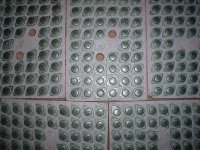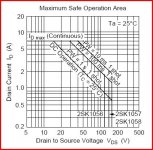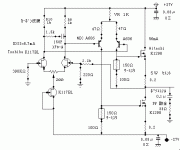janneman said:the Rdson, about 0.01 ohms
0.01 ??
Did someone say decent complementary ?
Cost difference between a 4-device vertical MOSFET output stage and an 8-device Lateral Mosfet one is like $20-$25, makes 50 bucks difference for stereo.
Which is Hogwash, compared to the total cost of the powersupply and (proper) amp case.
Attachments
jacco vermeulen said:
0.01 ??
[snip]
Hi Jacco,
He banged the gate with 9V he said, so he was switching them fully on. Vds close to zero.
Jan Didden
Thanks for all the comments,
Jacco, cost is a factor for sure. A double die lateral is around £12 GPB. So four of those £50 say all in. The verticals do have an advantage.
Tempco issues. The verticals are critical on biasing if you want to run at reasonable quiescent currents. I found 120 ma enough, but the challenge is getting this value from cold and maintaining it through all conditions
Rds on. What is the rds of a fully saturated lateral ( single die ) I would have guessed at not much lower than 1 ohm , says he looking at the data sheet. Not specified as such, can be as high as 12 volts at max drain current. Calculator time -- 1.7 ohms.
That's why the verticals can bite ! They can become nearly a piece of wire when saturated , not a good choice of words that is it.
, not a good choice of words that is it.
Gate zobels -- values, connections -- dunno, have to experiment on that one. To be honest I have found them (verticals) brilliant as regards stability etc. Must be doing something wrong
Jacco, cost is a factor for sure. A double die lateral is around £12 GPB. So four of those £50 say all in. The verticals do have an advantage.
Tempco issues. The verticals are critical on biasing if you want to run at reasonable quiescent currents. I found 120 ma enough, but the challenge is getting this value from cold and maintaining it through all conditions
Rds on. What is the rds of a fully saturated lateral ( single die ) I would have guessed at not much lower than 1 ohm , says he looking at the data sheet. Not specified as such, can be as high as 12 volts at max drain current. Calculator time -- 1.7 ohms.
That's why the verticals can bite ! They can become nearly a piece of wire when saturated
Gate zobels -- values, connections -- dunno, have to experiment on that one. To be honest I have found them (verticals) brilliant as regards stability etc. Must be doing something wrong
janneman said:
Hi Jacco,
He banged the gate with 9V he said, so he was switching them fully on. Vds close to zero.
Jan Didden
Rdson of the laterals is in the 1-2 ohm range when fully saturated - but the current when they desaturate is low with 9V gate bias. With 9V on the gate the initial current is about 10-15 amps with a stone cold fet but decreases quickly as the 500W+ dissipation heats the die pretty fast. The power supply did not current limit and sag during the test and there is a lot of output capacitance in it. Vds was 50V during the whole test.
The transconductance/resistance change causes the current to drop fast. About 6A after a couple tenths of a second which fell to about 2A after a few seconds. A while after that the transistor got hot enough for the internal zeners to start clamping the gate at a lower than usual voltage and if the current into the gate terminal exceeded about 10mA they latched up like thyristors dropping drain current to about 0.2A.
If the current into the gate terminal was kept low enough to not make the zeners latch up the transistor would respond to decreasing Vds with increasing Ids to keep the same temperature and power dissipation!
This here gathering is DIY and not commercial enterprising, right ?
Hop-shopping across the frontier buys single-die lateral MOSFETs for as low as $3/pc +taxes.
Around the corner boutique parlors easily charge $5 for a vertical MOSFET, and without a guarantee that you'll receive all same batch items !
A decent output stage requires at least 4 output devices for thermal efficiency reasons, no matter the type of output device.
It doesn't take 3 to 4 times as many Lateral MOSFETs to achieve comparable transconductance numbers as a Verti-M output stage.
Read what EUVL had to say about Gm numbers of Lateral/Vertical parts, and about not to read datasheets as the book of psalm.
Lateral MOSFETs are not expensive, they cost less than 25 years ago.
And 25 years ago, a Vertical MOSFET cost more than a Lateral one on this continent.
If someone isn't building crab amps, he'd have to buy more Vertical output devices than the required number he needs if he's going through the regular vendor channels.
Tolerances of Vertical parts are larger than those of (Japanese) Laterals.
If cost is an issue, then you'd also have to add the paid VA that is lost because of the difference in Gate voltage threshold to the balance.
Hop-shopping across the frontier buys single-die lateral MOSFETs for as low as $3/pc +taxes.
Around the corner boutique parlors easily charge $5 for a vertical MOSFET, and without a guarantee that you'll receive all same batch items !
A decent output stage requires at least 4 output devices for thermal efficiency reasons, no matter the type of output device.
It doesn't take 3 to 4 times as many Lateral MOSFETs to achieve comparable transconductance numbers as a Verti-M output stage.
Read what EUVL had to say about Gm numbers of Lateral/Vertical parts, and about not to read datasheets as the book of psalm.
Lateral MOSFETs are not expensive, they cost less than 25 years ago.
And 25 years ago, a Vertical MOSFET cost more than a Lateral one on this continent.
If someone isn't building crab amps, he'd have to buy more Vertical output devices than the required number he needs if he's going through the regular vendor channels.
Tolerances of Vertical parts are larger than those of (Japanese) Laterals.
If cost is an issue, then you'd also have to add the paid VA that is lost because of the difference in Gate voltage threshold to the balance.
unclejed613 said:unlike tubes, gates should never draw any current. unless they're shorted to the channel or they have internal zener protection. with RF there's also the possibility of RF current into the gate capacitance.
You bet there will be gate current required to drive the mosfets at RF. It requires a bit of energy to push and pull the majority carriers into and out of the channel at such speeds.
VFETs actually have a positive tempco only up to a point (up to about 100mA or so, sometimes as high as 1 amp) after that it turns negative like L-MOSFETs. that explains why they behave better with higher bias current.
Yes as pointed out, this is backwards, some verticals like hexfets have a zero temp co at many amps. For example, a 47 amp hexfet transistor zero temp co may be ~30A. A little bit high for a bias current I would think.
The change in transconductance wrt Vgs and temperature is another motivating factor for error correction.
If used properly, I agree with Bob, they just can't be beat, but there are certainly some drawbacks one must deal with.


Hi,
In enhancement types, the control electrode is isolated from the current conducting channel, resulting in practically zero gate current and infinite input impedance. The on-state drive current is zero as well.
MOSFETs have a resistive nature, RdsOn of Hitachi devices is 1Ohm @ Ta=25°C, promoting linearity. MOSFETs exhibit a positive temperature coefficient of 0.7%/°C to 1%/°C (- 2.2mV/°C for p-n junction), acting as a negative feedback in parallel operation. RdsOn increases, Gm decreases with increasing temperature.
The lateral structure is not efficient. The price of efficiency is always sound quality.
In enhancement types, the control electrode is isolated from the current conducting channel, resulting in practically zero gate current and infinite input impedance. The on-state drive current is zero as well.
MOSFETs have a resistive nature, RdsOn of Hitachi devices is 1Ohm @ Ta=25°C, promoting linearity. MOSFETs exhibit a positive temperature coefficient of 0.7%/°C to 1%/°C (- 2.2mV/°C for p-n junction), acting as a negative feedback in parallel operation. RdsOn increases, Gm decreases with increasing temperature.
The lateral structure is not efficient. The price of efficiency is always sound quality.
Hi,
In enhancement types, the control electrode is isolated from the current conducting channel, resulting in practically zero gate current and infinite input impedance. The on-state drive current is zero as well.
True....at 0 Hz.
change in Vgs across the input capacitance requires AC current to drive because Z=1/(2pi*F*C) Also there is Cdg in there too...also not very linear wrt Vds.

Lumba that topology has many flaws like cross conduction at HF with open loads. But its a basic one, its also used by Quasi in one of his amps.
There are many other topologies which are good and offer nice performance. Have a look at this
http://www.diyaudio.com/forums/attachment.php?s=&postid=937736&stamp=1150022131
There are many other topologies which are good and offer nice performance. Have a look at this
http://www.diyaudio.com/forums/attachment.php?s=&postid=937736&stamp=1150022131
You just know it will sound "right" though. You could develop it as far as you wish.
Or you could build my MOSFET amp Who said that !
Who said that !
When you start a thread it's good to see how it develops. Now what was the original question, oh yes, would a design using laterals put you off. Answer yes or no.
Brilliant feedback guys, it's good to know what you all think. Keep going.
Or you could build my MOSFET amp
When you start a thread it's good to see how it develops. Now what was the original question, oh yes, would a design using laterals put you off. Answer yes or no.
Brilliant feedback guys, it's good to know what you all think. Keep going.
- Status
- This old topic is closed. If you want to reopen this topic, contact a moderator using the "Report Post" button.
- Home
- Amplifiers
- Solid State
- Output stage device types. Yes or no question.


